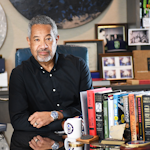Comedian Jerry Seinfeld once said this about public speaking:
“According to most studies, people’s number one fear is public speaking. Number two is death. Death is number two. Does that sound right? This means to the average person, if you go to a funeral, you’re better off in the casket than delivering the eulogy.”
Seinfeld was being funny, but he was also spot-on. Most people have a fear of public speaking. When I was in school, I too had that fear. I hated the thought of getting up in front of the class and either saying or doing something stupid. I believe this is the basis for people’s fears about public speaking - feeling stupid and/or having people make fun of you.
But you cannot be an effective leader without honing the craft of public speaking. Leaders are often called upon to:
- Speak at staff meetings.
- Speak in front of a company’s board of directors.
- Speak at your own organization’s meetings.
- Speak to C Suite executives to get buy-in and funding for your essential strategies
- Speak at industry events or participate in panels at conferences
Leaders will have to face these types of engagements sometime in their careers. When you are the leader of an organization, you represent that organization. Yes, it is important that you can communicate via the written word. But without the ability to effectively speak in public, you will never be the proverbial “full package” when it comes to leadership. Your team will know it … and so will you.
During my 16 years at Microsoft, I had a lot of opportunities to hone my public speaking skills. I ran a global organization. I often had to speak to my teams in the U.S. and internationally via teleconferencing and in person. It was up to me, and my leadership team, to keep our teams informed of our strategies, new initiatives, and engage them on their thoughts, ideas, suggestions and sometimes, complaints. Speaking to my teams effectively was essential to keep them united and moving in the same direction.
The first major speech I made was in the early 2000s at an event in Seattle called The Great Conversation. It was held at the Bell Harbor International Conference Center. The attendees were a mixture of security technology experts, along with end users, there were hundreds in attendance. I was nervous but decided to prep accordingly for this speech. Within Microsoft’s headquarters building, I found vacant office space on the floor where my office was located. I took three boxes and drew smiley faces on them—my new companions. I then placed them in front of me, one to the left, one in the center, and one to the right. Now I had my “audience.” Out came my PowerPoint deck along with a timer. Daily, I practiced my speech -- and my boxes never complained.
Zapping any notion of just looking straight ahead while speaking, I accustomed myself to look at the audience, right/center/left, left/center/right or center/right or center/left. I trained myself to engage the audience—all three of those formidable boxes—with my eyes and body language. I used a timer to hone my speech, so that I could meet the time limit given to me -- 45 minutes for the presentation, leaving another 15 minutes for Q&A.
I studied people who I felt knew how to give great speeches. People like Barak Obama, John F. Kennedy, Martin Luthor King, and Representative Shirley Chisholm. They were just a few of the leaders whose speeches I listened to and studied. I wasn’t trying to imitate them. I was studying their cadence. I was trying to envision if they were standing behind a podium or walking around the stage when they spoke. I looked at how they threw in humor to help break the ice and keep the audience engaged. Did they tell jokes, or did they just find the right time to say something humorous extemporaneously or insert a poignant story?
By the time I gave the speech at The Great Conversation, I was more than ready. The speech was a success and I received incredibly positive feedback from the audience and organizers. Over the years at Microsoft, I took every opportunity to speak in public. I now love it, even relish it.
The art of speaking is not a nice-to-have skill for leaders. It is essential. Don’t be afraid to get out there and speak. You have things to say that other people want to hear. You have your team to advocate for and sometimes defend. You have strategies and breakthroughs that you want the world to know about. You are the leader. You represent your organization and its members. Be bold, be brave, and speak up. You’ll be a better leader for it.
About the author: Mike Howard currently is President of Howard Consulting Services, LLC, a security consulting and mentoring firm based out of Las Vegas Nevada. Howard is the former Chief Security Officer (CSO) for Microsoft Corporation and held global responsibility for vital security functions including operations, investigations, risk mitigation, crisis management, executive protection, security technology, strategy, intelligence, and employee awareness. Mike was the CSO of Microsoft for 16 years. Mike speaks regularly as a subject matter expert on security and leadership while using his extensive security background to help drive industry innovation.
He spent 22 years with the Central Intelligence Agency, finishing as a Chief of Station. Mike also worked in the CIA’s Office of Security and served on the security staff of the Director of Central Intelligence. He worked in the Counterterrorism Center, ran global programs, and served in assignments around the world. Mike’s first book, “The Art of Ronin Leadership,” is available now.



